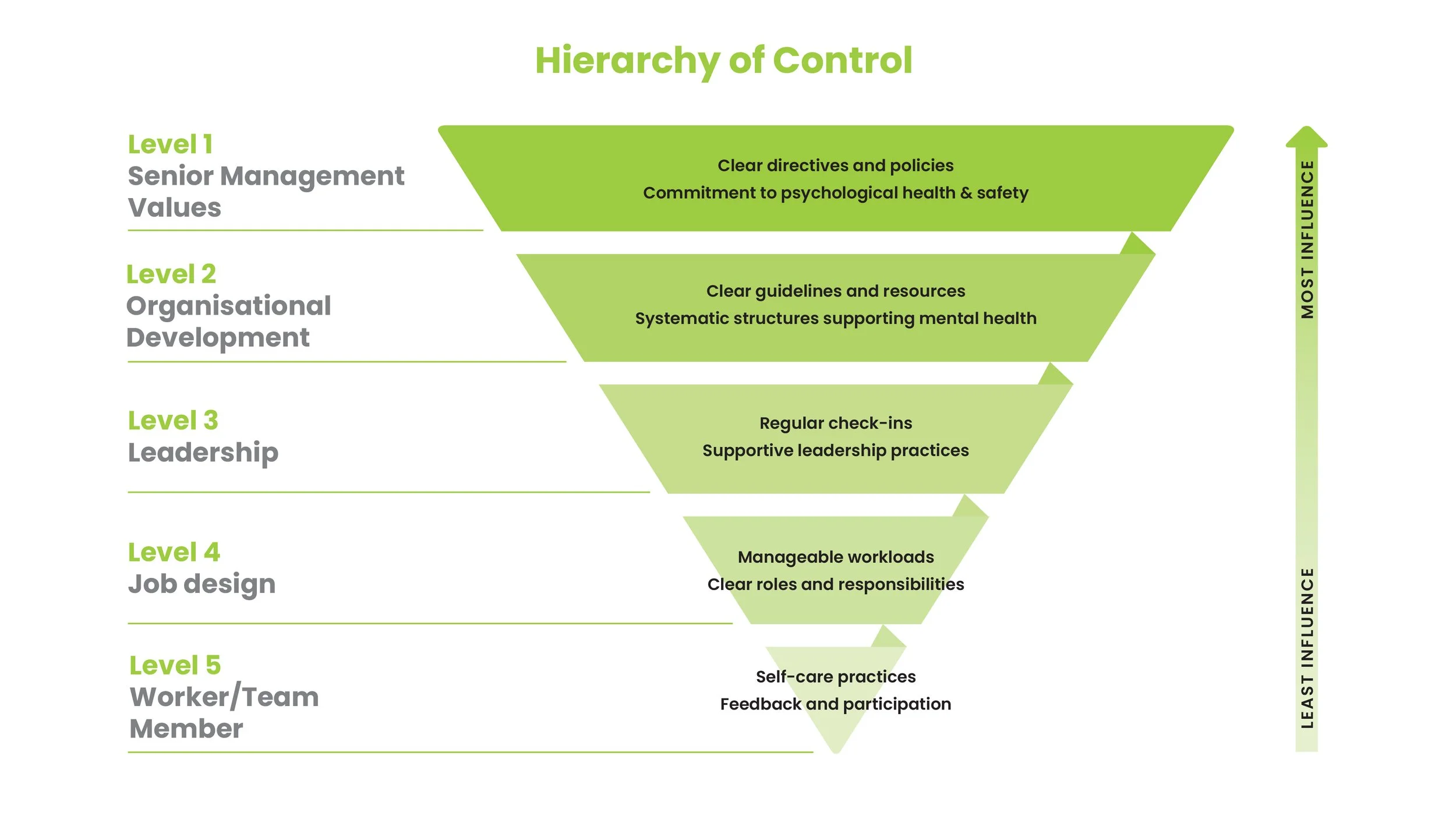In Part 1, we introduced the Psychosocial Safety Climate Hierarchy of Control (PSC-HOC) framework and outlined its five levels – from leadership commitment to individual worker strategies. Now, it’s time to look at what this means in practice.
How can organisations assess their current state? Where should they focus their efforts for the greatest impact? And what does a real commitment to psychological wellbeing look like? In Part 2, Dr Chanvi Singh answers these questions and provides clear, actionable steps to embed psychological safety into the way work is done.

Bailey, T. S., & Dollard, M. F. (2014). Psychosocial hazard management and the Psychosocial Safety Climate Hierarchy of Control (PSC-HOC). In The Australian Workplace Barometer. Australian Academic Press.
Putting the Psychosocial Safety Climate Hierarchy of Control (PSC-HOC) framework into action means addressing wellbeing at every level. Here are the key steps organisations can take to embed psychological safety into their culture at every level. Read Part 1 to find out more about the different levels of the hierarchy.
Level 1: Senior Management Values & Commitment
-
Develop clear, specific policies on psychological health
-
Ensure psychological safety metrics are reviewed with the same rigour as financial metrics
-
Allocate meaningful resources to psychological wellbeing initiatives
-
Demonstrate zero tolerance for psychologically harmful behaviours
Level 2: Organisational Development & Systems
-
Create transparent, accessible reporting systems for psychological hazards
-
Develop toolkits for managers to address wellbeing issues
-
Design onboarding processes that emphasise psychological safety
-
Implement regular psychosocial risk assessments
Level 3: Leadership Capability & Behaviour
-
Equip leaders with practical skills to identify early warning signs
-
Train managers in having effective wellbeing conversations
-
Include psychological safety leadership in performance metrics
-
Encourage leaders to model sustainable work practices
Level 4: Job Design & Work Environment
-
Review workloads to ensure they’re genuinely manageable
-
Design roles with appropriate autonomy and decision-making authority
-
Build in opportunities for skill development and growth
-
Ensure adequate resources match the demands placed on workers
Level 5: Individual Worker Strategies
-
Encourage personal boundary-setting and recovery practices
-
Promote peer support networks
-
Empower workers to speak up about psychological hazards
-
Support skill development for psychological self-care
Making the Shift in Your Organisation
Moving from psychological band-aids to systemic solutions doesn’t happen overnight, but these practical steps can start your journey:
-
Start with honest assessment: Gather data on your current state across all five levels through anonymous surveys, focus groups, and leadership interviews.
-
Secure genuine leadership commitment: This isn’t about fancy statements—it’s about leaders who demonstrate commitment to psychological wellbeing through their actions and decisions.
-
Target your biggest leverage points: Often, small shifts at senior leadership or organisational systems levels create bigger impacts than massive investments in individual resilience.
-
Build capability at all levels: Ensure people throughout the organisation understand the framework and have the skills to contribute to psychological safety.
-
Measure what matters: Track meaningful metrics that show real impact, not just activity—psychological injury rates, engagement scores, or productivity measures tied to wellbeing initiatives.
From Surviving to Thriving
The workplace wellbeing conversation is finally maturing beyond simplistic resilience narratives. The PSC-HOC framework offers not just a theoretical model but a practical roadmap for creating environments where people can truly thrive rather than merely survive.
When organisations stop asking “How do we help our people cope better with difficult work environments?” and start asking “How do we create work environments that enable our people to thrive?” – that shift changes everything.
Shifting from individual resilience to systemic responsibility isn’t just the future of workplace wellbeing – it’s the key to creating environments where people can truly thrive.
Dr. Chanvi Singh is a practitioner-academic (pracademic) in Work and Organisational Psychology, specialising in translating complex theories into practical workplace solutions for the evolving future of work. Her expertise spans organisational culture, leadership development, workplace innovation, and evidence-based change management.




